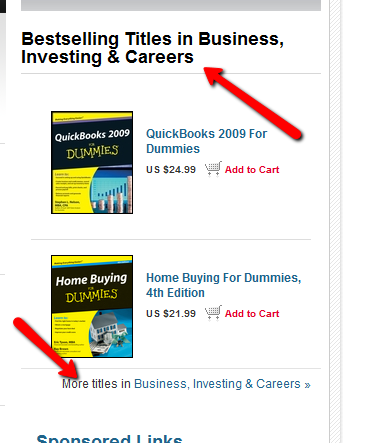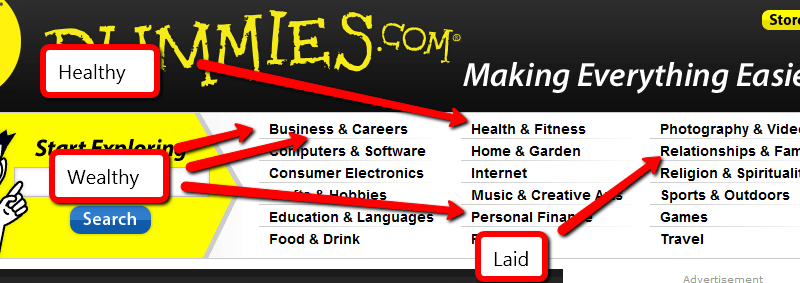- @ScottATaylor Thanks for following me. in reply to ScottATaylor #
- RT @ChristianPF: 5 Tips For Dealing With Your Medical Debt http://su.pr/2cxS1e #
- Dining Out vs Cooking In: http://su.pr/3JsGoG #
- RT: @BudgetsAreSexy: Be Proud of Your Emergency Fund! http://tinyurl.com/yhjo88l ($1,000 is better than $0.00) #
- [Read more…] about Twitter Weekly Updates for 2009-12-12
Make Extra Money Part 2: Niche Selection
If you want to make money, help someone get healthy, wealthy or laid.
This section was quick.
Seriously, those three topics have been making people rich since the invention of rich. Knowing that isn’t enough. If you want to make some money in the health niche, are you going to help people lose weight, add muscle, relieve stress, or reduce the symptoms of some unpleasant medical condition? Those are called “sub-niches”. (Side question: Viagra is a sub-niche of which topic?)
Still not enough.
If you’re going to offer a product to help lose weight, does it revolve around diet, exercise, or both? For medical conditions, is it a way to soothe eczema, instructions for a diabetic diet, a cure for boils, or help with acne? Those are micro-niches.
That’s where you want to be. The “make money” niche is far too broad for anyone to effectively compete. The “make money online” sub-niche is still crazy. When you get to the “make money buying and selling websites” micro-niche, you’re in a territory that leaves room for competition, without costing thousands of dollars to get involved.
Remember that: The more narrowly you define your niche market, the easier it is to compete. You can take that too far. The “lose weight by eating nothing but onions, alfalfa, and imitation caramel sauce” micro-niche is probably too narrowly defined to have a market worth pursuing. You need a micro-niche with buyers, preferably a lot of them.
Now the hard part.
How do you find a niche with a lot of potential customers? Big companies pay millions of dollars every year to do that kind of market research.
Naturally, I recommend you spend millions of dollars on market research.
No?
Here’s the part where I make this entire series worth every penny you’ve paid. Times 10.
Steal the research.
My favorite source of niche market research to steal is http://www.dummies.com/. Click the link and notice all of the wonderful niches at the top of the page. Jon Wiley & Sons, Inc. spends millions of dollars to know what topics will be good sellers. They’ve been doing this a long time. Trust their work.

You don’t have to concentrate on the topics I’ve helpfully highlighted, but they will make it easier for you. Other niches can be profitable, too.
Golf is a great example. Golfers spend money to play the game. You don’t become a golfer without having some discretionary money to spend on it. I’d recommend against consumer electronics. There is a lot of competition for anything popular, and most of that is available for free. If you choose to promote some high-end gear using your Amazon affiliate link, you’re still only looking at a 3% commission.
I like to stick to topics that people “need” an answer for, and can find that answer in ebook form, since I will be promoting a specific product.
With that in mind, pick a topic, then click one of the links to the actual titles for sale. The “best selling titles” links are a gold mine. You can jump straight to the dummies store, if you’d like.
Of the topics above, here’s how I would narrow it down:
1. Business and Careers. The bestsellers here are Quickbooks and home buying. I’m not interested in either topic, so I’ll go into “More titles”. Here, the “urgent” niches look like job hunting and dealing with horrible coworkers. I’m also going to throw “writing copy” into the list because it’s something I have a hard time with.

2. Health and Fitness. My first thought was to do a site on diabetic cooking, but the cooking niche is too competitive. Childhood obesity, detox diets and back pain remedies strike me as worth pursuing. I’m leaning towards back pain, because I have a bad back. When you’ve thrown your back out, you’ve got nothing to do but lie on the couch and look for ways to make the pain stop. That’s urgency.
3. Personal Finance. The topics that look like good bets are foreclosures and bankruptcies. These are topics that can cost thousands of dollars if you get them wrong. I hate to promote a bankruptcy, but some people are out of choices. Foreclosure defense seems like a good choice. Losing your home comes with a sense of urgency, and helping people stay in their home makes me feel good.
4. Relationships and Family. Of these topics, divorce is probably a good seller. Dating advice definitely is. I’m not going to detail either one of those niches here. Divorce is depressing and sex, while fun, isn’t a topic I’m going to get into here. I try to be family friendly, most of the time. Weddings are great topic. Brides are planning to spend money and there’s no shortage of resources to promote.
So, the niches I’ve chosen are:
- Back pain
- Bankruptcy
- Conflict resolution at work
- Detox diets
- Fat kids
- Foreclosure avoidance
- Job hunting
- Weddings
- Writing copy
I won’t be building 9 niche sites in this series. From here, I’m going to explore effective keywords/search terms and good products to support. There’s no guarantee I’ll find a good product with an affiliate program for a niche I’ve chosen that has keywords that are both highly searched and low competition, so I’m giving myself alternatives.
For those of you following along at home, take some time to find 5-10 niches you’d be willing to promote.
The important things to consider are:
1. Does it make me feel dirty to promote it?
2. Will there be customers willing to spend money on it?
3. Will those customers have an urgent need to solve a problem?
I’ve built sites that ignore #3, and they don’t perform nearly as well as those that consider it. When I do niche sites, I promote a specific product. It’s pure affiliate marketing, so customers willing to spend money are necessarily my target audience.
Things to teach your kids about money

As parents, it is our job to teach our kids about a lot of things: driving, reading, manners, sex, ethics, and much, much more. How many of us spend the time and effort to teach our kids about money? A basic financial education would make money in early(and even late) adulthood easier to deal with. Unfortunately, money is considered taboo, even among the people we are closest to.
It’s time to shatter the taboo, at least at home. Our kids need a financial education at least as much as they need a sex education, and—properly done—both educations take place at home.
How do you know what to teach? One method is to look back at all of the things you’ve struggled with and make sure your kids know more than you did. If that won’t work, you can use this list.
- Balance a checkbook. This is the most basic of financial skills. The easiest way to teach this is to help him open a checking account and demand he keeps the register current and reconciled. Make him use a paper register. Quicken or an alternative may handle the work, but your kid will never learn the underlying principles if he doesn’t have to sit down with a pen and calculator to do the work. The cheat can come later, when he is capable of handling the task himself. It’s the same reason schools don’t let kids use calculators until the basics are thoroughly mastered.
- Calculate paid interest. Understanding how much something costs after accounting for interest should be enough to scare anyone away from credit cards. I believe that the reason it doesn’t is because most people don’t understand how to figure out what interest is costing them. In case you don’t know yourself, the math is simple: balance X interest rate(as a decimal) / 12. That will show you how much you are paying each month for the privilege of borrowing money.
- Use your money to make money, not to pay interest. The flip side of interest is earned interest. It’s always best to let your money work for you, building your wealth than to struggle to finance a bank’s payroll liabilities.
- Save 25%. My son is required to put a quarter of everything he earns in his bank account. He gets $20 for shoveling the neighbor’s driveway, so $5 goes in the bank. The money he gets for gifts is handled the same way. Everything he gets, whether it be from a gift, his allowance, or work he does—gets divided the same way. If I can establish that habit for him, and impress upon him the value of saving 25% enough that he continues into adulthood, he will never have money problems.
- Always contribute to retirement. At every opportunity, from every paycheck, make a contribution to retirement. At a minimum, a 401k contribution should be made at a level that takes full advantage of any company match. If there is no match, even $25 per paycheck will add up over time. Teach them to work towards the 401k contribution limits.
- Spend less than you earn. This is the shining, glorious foundational principle of successful finances. Not just individuals, but businesses and even governments should learn this lesson. If–at all times–you are spending less than you earn, you will have more options to handle the remaining bits. If you live on the wrong side of this equation, you will never be able to get ahead, no matter how hard you work.
Those are the lessons that I am working to instill in my children, a little at a time. Am I missing any?
Side Hustle: Garage Sale Management

Pre-sale preparation and marketing are important, but ultimately, the money comes from how you manage the sale.
How many people will you have staffing the sale? There are a few considerations here. How many people are involved in the sale? How many people can take the time off? It’s best to have three people at the sale at all times. Two people can manage the money while the third plays salesman and security. Staffer #3 is in charge of watching for price-tag swaps or other theft, answering questions, and trying to upsell. It also allows for breaks, which, if you’ve ever spent a day in a garage drinking coffee, is important.
When are you going to be open? You don’t want to open so early you don’t have time to wake up and get ready for the sale, but you don’t want to open so late the professional garage-salers drive past and forget about you. Plan to open sometime between 7 and 9. When will you close? Staying open until 6 will catch most of the after-work crowd, but it makes for a long day, but closing at four cuts out a lot of the late-day shoppers. Our hours were 8-5, which seemed to be a good compromise between a long day and the best sale.
[ad name=”inlineleft”]Don’t be afraid to shut down. The first day of our sale was cold, wet, and miserable. We had to canopies in the driveway, but everything was getting wet, anyway. Traffic was slow and we weren’t enjoying ourselves, so we shut down. Lunch and a nap improved our outlook considerably. At the end of the day, we start packing up, even if people were there. We tried to only pack what they had looked at, and we didn’t try to rush the potential customers, but we did let them know that the sale was ending for the day. The folks who came in half an hour after close on the last day seemed upset that we didn’t unpack everything for their amusement.
Our layout was designed to get everything easily visible while maximizing traffic. The first day, we were confined to the garage and tents, so space was limited. There were baskets under each of the tables. That forced people to crouch and block each other. The second day, we expanded to fill the driveway. Our tables were organized in 3 rows–a “U” shape with a double-wide row of tables in the middle. This allowed people to see everything in one pass. The middle row had periodic breaks so we could move around to help the customers. The pay table was in the middle of one of the outer rows, which let us monitor the entire sale.
Find someone to watch the kids and pets. If you have to keep an eye on your children, you aren’t watching the customers or giving them the attention they need. Your dog–no matter how well-behaved–is a liability. It will be stressed at the people. Some customers will be allergic or afraid. Just don’t do it.
Ideally, you will have someone who isn’t taking money, knows a little bit about most of the merchandise, and isn’t too shy to talk to strangers. His job is to wander around, answer questions, and help people decide if they want an item. He’s the sales-weasel. If he’s pushy, he’ll chase off the customers, but if he’s hiding, he isn’t making any money. Unusual items should have a sign attached explaining why they are special, so the sales-weasel doesn’t have to explain it to everyone.
Every single item should be priced, but not everything needs to be priced individually. We priced all of the movies in a group. “VHS: $0.50 or 5 for $2, DVD $3 or 4 for $10”. Nobody should have to ask what an item costs. If there are multiple people doing a sale together, make sure everyone is using colored price tags to identify who is selling what.
People come to garage sales expecting to find good deals. If they don’t, they’ll leave. Our rule of thumb for pricing was about 25% of retail, with wiggle-room for the item’s condition. New-in-the-box sometimes made it up to 50% of retail. Our goal was primarily to reduce clutter, so a lot of items were priced at 10%. You have to keep in mind that, if you price things too low, people will assume there is something wrong with it and not assign a value in their own minds. Price it at what you would be willing to pay in a garage sale, then mark it up–just a bit–to account for haggling.
People love to haggle at garage sales. It gives them an opportunity to brag about the great deal they fought for. Try to accommodate them. One of the people participating in our sale was selling antiques with a definite value. She didn’t want to haggle on any prices, so we simply hung up a sign that read “All white-tagged prices are firm.” Everyone else was willing to accept almost any reasonable offer. Our most important rule for accepting a price? If you pissed me off, I didn’t budge on price. Insult me, or offer 1/10 of the price, and my defenses go up, bringing your final price with it. Talk nice and use some common sense while haggling, and you got what you asked for.
[ad name=”inlineright”]Could we have maximized the sale more? Probably. I had intended to hang up a sign that simply said “$100” to set a high anchor-price on everything, but I forgot.
Note: The entire series is contained in the Garage Sale Manual on the sidebar.
Update: This post has been included in the Carnival of Personal Finance.
One Year Later….
In April of 2009, I told my wife we were either going to straighten out our finances or file bankruptcy. At that time, we had $90,394 in total debt, including $30,000 in credit card debt. It hasn’t been easy, but we are working out way out of that hole. Since then, we have paid down more than $30,000. That’s not $30,000 in payments, but $30,000 less debt. We are now less than $60,000 in debt. We have entirely stopped accumulating more and I don’t remember the last time we carried a new balance on a card or had to use our overdraft protection. Next month, my car will be paid off, 10 months early.
Given my new-found fanaticism, I spent the next 6 months or so evangelizing about our debt repayment. Eventually, I decided to share my thoughts and progress with the world and launched this site on December 1, 2009. Today is my anniversary.
Here we are, 234 posts, 695 comments, and 17, 661 spam later. You all rock. Except the spammers.
To say thank you, I’m giving away a $100 Amazon gift card to some lucky reader. Yes, I rock, too.
There are several ways you can enter the drawing:
1. Subscribe to Live Real, Now, either by RSS or email. If you are already subscribed by email, you are automatically entered. To show me you have subscribed by RSS, there is a contest code in the feed. Just post that in the comments. (1 entry)
2. Follow me on twitter and tweet the following: “@LiveRealNow is giving away $100. Come get some! Follow and RT to enter! http://bit.ly/f1roKM #Giveaway #Yakezie” (1 entry possible per day. Every day you retweet this is another entry!)
3. “Like” LRN on Facebook. This is easy, just click the little ‘like’ button on the left. If you’ve already done that, you have already entered once.(1 entry)
4. Send me an email at Jason <AT> LiveRealNow <DOT> net telling me what you would like to see me write about more (or less!). You can also use the contact form. (1 entry)
I’m closing this down on the 15th. That’s 18 possible entries for $100 you may win early enough to help with some last-minute Christmas shopping.
UPDATE:
And the winner is…Claudia! Congratulations. Email sent.
What Is Your Binary Options Strategy?
 When you are just entering the world of binary options trading or investing, you may be on the receiving end of a lot of advice. It is not uncommon to hear people tell you to implement different gambling strategies because binary options are based on chance more than anything else. You will also hear a lot of advice from those who say there are many good ways to develop an effective strategy using indicators and market signals. Some will insist that with proper analysis of market data, a solid strategy can be developed too.
When you are just entering the world of binary options trading or investing, you may be on the receiving end of a lot of advice. It is not uncommon to hear people tell you to implement different gambling strategies because binary options are based on chance more than anything else. You will also hear a lot of advice from those who say there are many good ways to develop an effective strategy using indicators and market signals. Some will insist that with proper analysis of market data, a solid strategy can be developed too.
Are they all correct? Interestingly enough, the answer is yes. The reason for this is simple, and as one expert writes, “there is no such thing as a perfect strategy for every trader. There is only a best strategy for each individual trader.” Thus, your strategy has to be shaped around a few things:
- Your willingness and ability to follow your chosen strategy.
- Your personality. For instance, are you restless if you are taking the safe route or a higher risk strategy?
- Your budget and goals,
Identifying the answers to these questions is the first step to formulating a strategy. You should also understand that the winning percentage of most strategies will be somewhat constant, but the total number of successful trades varies on an individual basis and is based entirely on the strategies used.
For instance, some investors want a high percentage of winning trades and are more comfortable with risk averse trading. Others are ready to take more risk and are entirely comfortable winning fewer trades if the returns on winning trades are dramatically higher. This enables them to implement higher risk trades. The interesting thing about strategies and the kinds of trades they generate is that they are all built from the same data.
The Data of Strategy
For example, almost all strategies will look at issues like market trends, trading trends, highs and lows, reversals, and various kinds of indicators. The reason that high and low trends pay off in strategy development is simple: binary options trading applies to whether or not an asset rises above a strike price or doesn’t. It is the proverbial “yes or no” part of the proposition and analysis for either outcome pays off.
As an example, a lot of risk-averse investors will look for breakouts. They use these for trend line investing, which can be as brief as sixty seconds to a day, but can be used to coordinate investing in the direction of a short trend. Although this seems complex, it really is not. The key is that analysis cannot be broad and across all available markets. Instead, focused analysis on a specific area will allow even a novice investor to analyze for a breakout and then invest in binary options accordingly.
Just being able to detect a reversal or a downward trend over the course of a day can yield a very rewarding investment. The key is to understand your strategy based on your budget, personality, and your ability to stick with the strategy, even if it does not yield immediate success. When you do this, and use the right tools for analysis, you can create an effective strategy that brings you closer to your goals.
This is a guest post.


